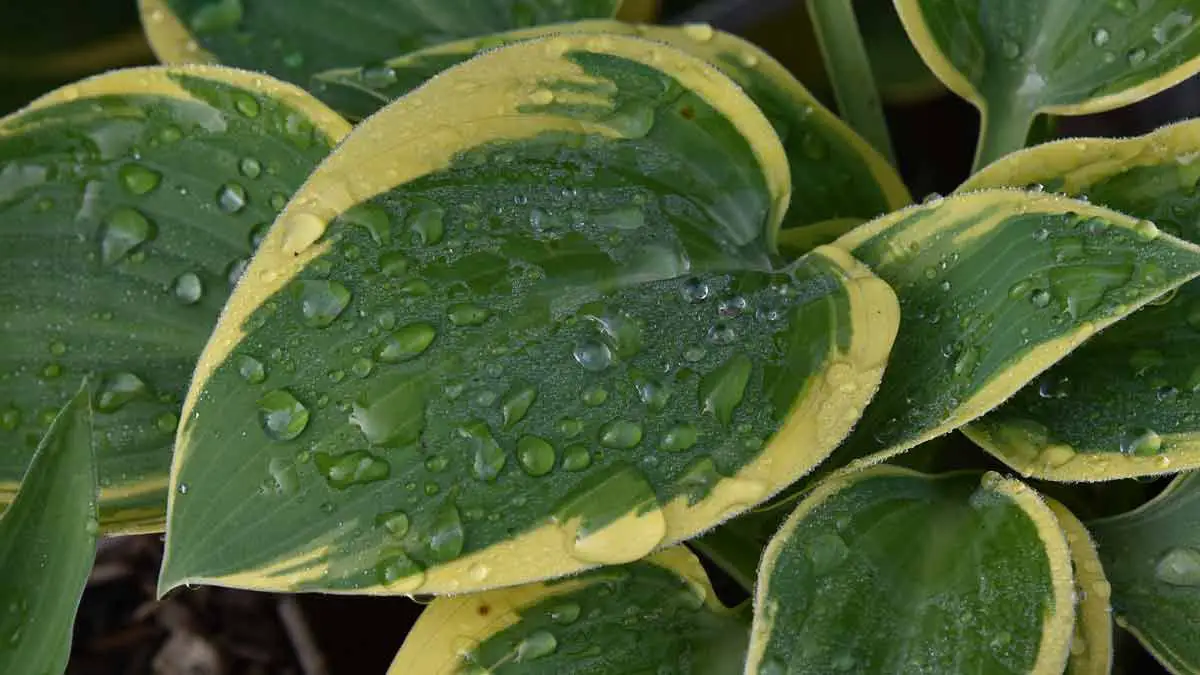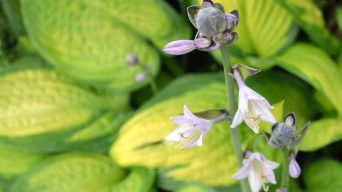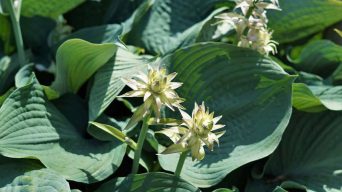Hostas, also known as plantain lilies, are a staple in many gardens and landscapes, with their beautiful foliage ad low maintenance needs.
However, it is crucial to be careful not to overwater these plants, as excess moisture can lead to various issues.
This article will delve into the dangers of overwatering hosta plants, identifying if your hosta is overwatered, and how to save an overwatered hosta. We will also offer tips on preventing your hosta plant from being overwatered.
By following these guidelines, you can ensure that your hosta remains healthy and strong.
What Are the Risks of Overwatering Hosta Plants?
Overwatering can introduce several issues and risks when it comes to hosta plants. The most common problems caused by overwatering are:
Root Rot
When a hosta plant is overwatered, the soil becomes overly saturated and stays moist for extended periods. This environment is ideal for certain fungi and bacteria, which can lead to root rot.
The plant’s roots will become soft and discolored, making it difficult for the hosta to absorb nutrients and water. This can weaken the plant significantly, eventually leading to its death if not addressed quickly.
Fungi and Bacterial Infections
Excess moisture can also encourage the growth of fungi and bacteria, leading to plant diseases. These infections often cause leaf spots or lesions on the hosta leaves, as well as yellowing and wilting.
If left untreated, these infections will spread to other parts of the plant and can eventually kill the hosta.
Yellowing and Wilting Leaves
Excessive watering may result in hosta leaves yellowing and wilting, adversely affecting the plant’s well-being and visual appeal. This typically stems from soil oversaturation, reducing oxygen levels and culminating in root demise.
The yellowed leaves will eventually turn brown and fall off, leaving the hosta looking unsightly.
How Does Overwatering a Hosta Occur?
Overwatering a hosta plant can occur for a variety of reasons, including:
Using Soil That Doesn’t Drain Well
Hosta plants need soil that drains quickly and adequately, as their roots can easily become too wet and rot.
If you use soil that doesn’t drain well, such as clay-based soil, your hosta will be more susceptible to becoming overwatered.
A potting mix designed for potted plants is a great option, as it will provide the drainage needed and help to keep your hosta from becoming too wet.
Watering Too Frequently or in Large Quantities
Watering your hosta too frequently or in large quantities can also contribute to overwatering.
Hostas don’t need a lot of water, so it’s important not to give them more than they need.
It’s best to check the soil before each watering and water only when the soil is dry.
Also, remember that hostas need less water during cooler months and more water during warmer months.
For the best results, water hostas deeply but infrequently.
Planting in an Area With Poor Drainage
Planting your hosta in a spot with limited drainage will likely lead to overwatering.
Select a spot where the soil drains quickly and is sheltered from strong winds or direct sunlight.
If you have a potted hosta plant, make sure the pot has holes in the bottom to allow excess water to drain away.
Depending on the type of container you use, you may need to add some additional soil or a potting mix.
Applying Too Much Fertilizer
Fertilizing may be necessary to help keep your hosta healthy, but it’s important not to overdo it.
Using too much fertilizer can lead to an accumulation of salts in the soil, making it difficult for water to drain properly, and can cause your hosta to become overwatered.
Be sure to follow the directions on the fertilizer and adjust the amount you use accordingly.
Using Hard Water
Finally, using hard water to water your hosta may also contribute to overwatering.
Hard water contains a high amount of dissolved minerals and salts, which can accumulate in the soil and prevent it from draining properly.
It’s best to use filtered or distilled water free from minerals. If you do use tap water, allow it to sit for several hours before using it so that the minerals have time to settle.
How To Identify If Your Hosta Is Overwatered?
It’s essential to identify signs of overwatering in your hosta early on, as this will help you take the necessary steps to save it.
If not treated promptly, overwatered hostas can suffer severe damage and even die.
Signs of an Overwatered Hostas
There are a few telltale signs to look out for if you suspect your hosta is overwatered:
Yellowing or Wilting Leaves
When a hosta is overwatered, the leaves will start to yellow and wilt.
This happens because the waterlogged soil prevents oxygen from reaching the roots, and the plant cannot absorb enough water.
Soft or Mushy Stems
If your hosta’s stems feel soft and mushy, it could be a sign of overwatering.
This is because the roots cannot take up enough oxygen from the soil, so they cannot provide the necessary support for the stems.
Brown or Black Roots
Another sign of overwatering is brown or black roots, which indicate root rot caused by waterlogged soil.
The roots will also be soft and mushy.
Healthy roots should be firm and white.
Foul Odors
If your hosta has an unpleasant odor, it could be a sign of waterlogged soil and overwatering.
The smell is caused by bacteria in the soil breaking down organic matter due to excessive moisture.
It usually smells like rotting vegetables or moldy bread.
Mold or Fungus
Finally, mold or fungus growth on the soil surface is another sign of overwatering.
This happens when there’s too much moisture in the air for the plant to take up and evaporate.
Mold or fungus typically appears as gray, white, or yellow spots on the soil surface. It can also spread to the hosta leaves and stems.
How To Save an Overwatered Hosta Plant
If you find that your hosta plant is overwatered, there are steps you can take to help save it. Here’s what to do:
- Stop watering the plant immediately and allow the soil to dry out completely before attempting to water again. This will help prevent further damage caused by overwatering.
- If the leaves are wilting and the root system is soggy, likely, the root rot has already set in. If so, use a sharp knife to gently prune away any dead or dying parts of the plant.
- Move the plant to an area with better drainage and add a layer of mesh or pebbles to the bottom of the pot. This will help ensure that water isn’t standing in the pot for too long.
- Repot the plant into fresh soil and a new container, ensuring not to overwater it in its new home.
- Once you have repotted your hosta, give it plenty of indirect light and water only when the soil is dry. This will help ensure your plant gets the water it needs without becoming overwatered again.
These steps can help save your overwatered hosta plant. With patience and care, your shade loving hosta should be back to its former glory in no time!
How To Prevent Overwatering a Hosta Plant
Prevention is always better than cure. To avoid overwatering your hosta plant, follow the steps below:
1. Plant Your Hosta in Well-draining Soil
One crucial factor to consider when planting a hosta is that it should be planted in well-draining soil.
Clay soils are particularly prone to becoming waterlogged, as they don’t allow water to drain away quickly.
To prevent this, add some organic matter, such as compost or topsoil, to increase drainage.
2. Choose the Right Pot Size
Selecting a pot that is not too big for the plant can help to keep overwatering at bay.
A pot that is too big will cause the soil to remain wet for longer, leading to root rot.
3. Water Deeply
It’s important to remember that hosta plants like to be watered deeply and infrequently.
This helps to encourage strong root growth, as well as keep the plant hydrated.
Water your plant until you see excess water draining from the pot, and then leave it to dry out before watering again.
4. Monitor Moisture Levels
It is essential to regularly check the moisture levels in your hosta’s soil, especially during hot weather.
If the soil feels dry, then it’s time to give your plant some water.
If it is still wet, wait a few days before watering again.
5. Use Mulch
Using mulch around your hosta plants can also help keep moisture levels and prevent overwatering.
Organic mulches, such as pine needles and bark chips, will help to retain moisture in the soil and keep weeds away.
By following these steps, you can ensure that your hosta plant is well looked after and does not become overwatered.
Final Thoughts
When growing hosta plants, It’s important to know when it is time to give them the water they need.
Overwatering can be detrimental and lead to root rot and other problems; however, by paying attention to your plant’s needs, you can keep them healthy and thriving.
If you are still determining how much water a hosta plant needs, it is best to err on the side of caution and water less frequently. That way, you can avoid overwatering your hosta plants and create a beautiful garden for years.







